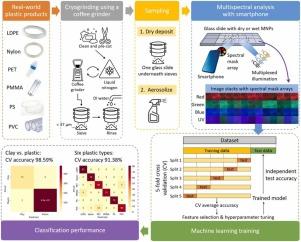Low-cost, multispectral machine learning classification of simulated airborne micro/nanoplastics
IF 12.2
1区 环境科学与生态学
Q1 ENGINEERING, ENVIRONMENTAL
引用次数: 0
Abstract
This study presents a novel smartphone-based, machine-learning-assisted multispectral classification method for identifying airborne micro- and nanoplastics (MNPs). Instead of commercial polymeric microspheres, coffee grinder-based cryogrinding generated nonuniform MNPs from real-world plastic products with highly irregular shapes and heterogenous size distributions. The low-cost handheld device comprises a smartphone, a spectral mask array made from plastic color films, and a discrete multiplexed illumination device. A stack of images was captured across multiple wavelength ranges, and the RGB ratios were extracted without using morphological information. An XGBoost model was trained on two datasets: dry and wet MNP samples passively collected on a glass slide, simulating two types of airborne MNPs. The model successfully distinguished plastics from clay with 89-99% accuracy and classified six plastic types with 79-87% accuracy for dry and wet MNPs. This method offers a promising toolkit for airborne MNP monitoring.

求助全文
约1分钟内获得全文
求助全文
来源期刊

Journal of Hazardous Materials
工程技术-工程:环境
CiteScore
25.40
自引率
5.90%
发文量
3059
审稿时长
58 days
期刊介绍:
The Journal of Hazardous Materials serves as a global platform for promoting cutting-edge research in the field of Environmental Science and Engineering. Our publication features a wide range of articles, including full-length research papers, review articles, and perspectives, with the aim of enhancing our understanding of the dangers and risks associated with various materials concerning public health and the environment. It is important to note that the term "environmental contaminants" refers specifically to substances that pose hazardous effects through contamination, while excluding those that do not have such impacts on the environment or human health. Moreover, we emphasize the distinction between wastes and hazardous materials in order to provide further clarity on the scope of the journal. We have a keen interest in exploring specific compounds and microbial agents that have adverse effects on the environment.
 求助内容:
求助内容: 应助结果提醒方式:
应助结果提醒方式:


